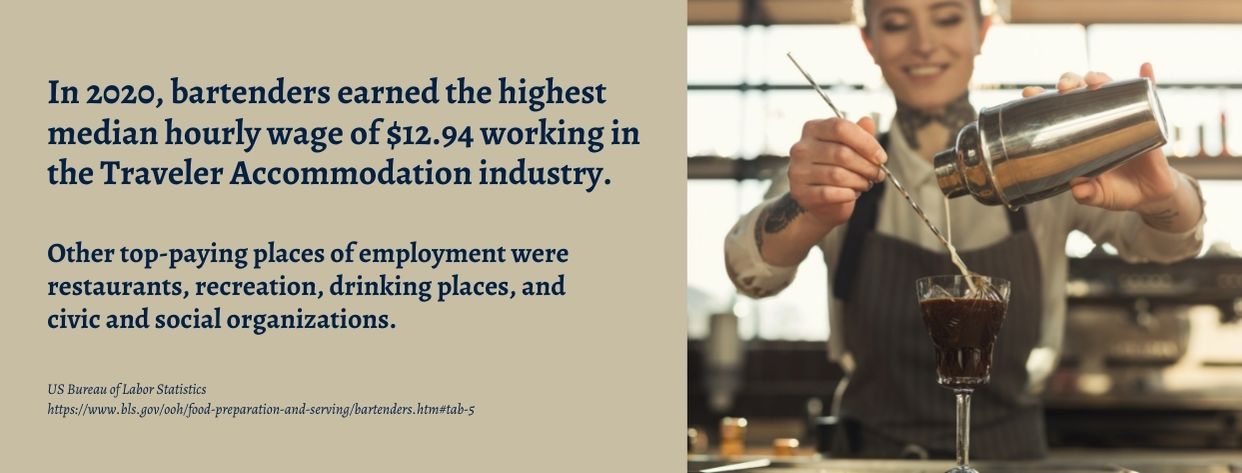Find Your Perfect School
Online bartending classes are one of the latest phenomena taking the beverage industry by storm for career-oriented training on the World Wide Web. And, unless you’ve been living under a rock, you probably know someone who has worked (or is currently working) as a bartender.
Bartending schools typically take six months or less for online students to gain the alcohol expertise and mixing skills for success behind the bar. Critics often misjudge online bartending classes by saying that only on-the-job experience helps individuals master this hands-on craft.
While experience is supreme, online bartending programs will bestow the basic know-how to get your foot in the door. Many are also designed to satisfy state-based Alcohol Seller/Server Certification for work at licensed liquor establishments.
Average Salary Statistics for Bartenders

After investing in formal bartending classes online, let’s look into how much money you’re likely to earn. But, I must tell you in advance that there is no definite answer. Bartending earnings depend on various factors, making it difficult to predict how much bartenders make.
Nonetheless, we will tackle this information, separate myths from realities, and provide a clearer picture of how much you will (or should) make as a bartender.
Bartending Salary Potential Based on Location: Highest Paid Bartenders
How much your online bartending classes pay off could be dictated by where you’re pouring the chardonnay and mixing the margaritas. Drinking establishments in Hawaii are a bartender’s paradise with America’s highest annual average income of $34,490, or $16.58 per hour before tips.
Bartenders in Kauai especially report huge average salaries of $64,630! Another top-paying state is California, where bartending jobs earn $33,890 annually. Bigger cities also fare well with bartending averages above $34,000. For example, Sarah Speros shared her story about making $96,000 each year total at her New York City bar.
Bartending Salary Potential Based on Tips
Tips account for approximately 75-85 percent of an average bartender’s earnings. For instance, if the average bartender in the United States earns $12/hour, tips alone bring in $9/hour. And if you’re earning at least $25 per hour, you’d be making about $18.75 per hour in tips.
As previously stated, the number of tips you receive is highly dependent on a variety of factors, making it difficult to predict. So for your convenience, we’ll break down each of these tipping factors to determine how much bartenders typically make in all situations.
- Shift period
For some, nighttime is the best time for a shift, especially on weekends. After all, it is the busiest time in most bars. The general thinking is; that the more cocktails you make and sell, the more tips you’ll get. However, some bartenders may argue with this and would say that day shifts are the best.
For one, day shifts are frequently shorter. There is usually only one rush, at lunchtime. From 11:30 a.m. to 1:30 p.m. The tables are not the same as during the night shift. Less alcohol (no bar tip out) and, quite often, individual checks are requested by a group of coworkers. Each check represents another opportunity for a guest to round up to the nearest dollar or add a buck to the tip just to be nice.
The slow shift also makes more sense. It will allow you to talk more with the customers, which consistently increases your chances of getting a decent tip.
- The type of bar/venue/event
The type of bar/venue/event you are working at will also significantly impact your end-of-shift pay.
To keep things simple, we’ll categorize venues and bars into three categories:
- upper class (where you’ll make the most from tips)
- middle class
- lower-class (where you’ll make the least from tips)
If you work at a lower-class bar, you’ll earn fewer tips than middle-class and upper-class bars. But how could you tell if it’s a lower-class bar? If you see a bar with a row of empty seats, it usually means that the bar isn’t very popular. Another indication of lower-class bars will be printed on the menu. Don’t expect to make much money if the drink prices are next to nothing.
So, how much tip should you be expecting with these bars? On a typical, slow weeknight, a bartender will earn between $40 and $50 in tips. On a busy night, a bartender in this class can earn up to $200, but not much more.
Examples of lower-class bars:
- Dive bars
- Small-chain restaurants
- Unpopular clubs
Next up is the middle-class bars. On a good night, you should earn between $200 and $500. On slow or bad nights, you should make at least $70.
The most significant distinction between the lower and middle classes is the number of “good nights” per week. Lower-class bars rely heavily on the weekend to cover all of their expenses, whereas middle-class bars have busy weekends and occasional weekdays.
Examples of middle-class bars:
- Sports bars
- Music venues
Lastly, the upper-class bars. Now here is the cherry on top—every bartender’s dream workplace. If you know someone who lives comfortably while bartending and earns more than $50,000 per year, it’s because he works at one of these establishments. Bartenders in these establishments make a minimum of $150 per night, an average of $500, and up to $1,000 on busy nights. If you’re working here, you’ve most likely had a lot of experience.
Examples of upper-class bars:
- High-end clubs
- Resorts
- Fine dining/expensive restaurants
- Popular city bars with a diverse selection of cocktail ingredients
Earning While Bartender Training
After reading all these pieces of information, you’re now probably wondering if you can earn while training as a bartender. The quick answer is “Yes!” There are several ways to earn money while working towards a Bartending Certification!
Getting a job while in training will benefit you even after your training program. Employers are more likely to hire you if you have experience in the field or something related.
Every student is qualified for employment through the staffing service. However, you cannot work as a bartender while undergoing bartender training. But that’s fine! Here’s a list of the best jobs you can get while you’re still in school.
1. Event Servers
The majority of event staffing jobs are in event serving. You will be assisting the catering or bar staff with serving food or beverages in this role. This frequently entails serving multiple drinks on a tray—don’t worry, it’s not as difficult as it appears!
So, how much can you earn in this job? The average event server salary is $29,250 per year or $15 per hour. Starting salaries for entry-level positions start at $25,350 per year, with most experienced workers earning up to $39,561 per year.
2. Bar Back
A bar back is an excellent way to earn and learn about bartending while training. Bar backs are responsible for setting up the bar, cutting and preparing garnishes, stocking drinks, and keeping glassware stocked for the bartender.
So, how much should you expect to be paid in this profession? According to Glassdoor, the average salary for a barback can range between $17,000 and $31,000 per year, depending on customer tips, the number of hours worked, and the employer’s pay policy. Most barbacks earn around $21,000 per year
Upward Mobility After Online Bartending Classes

Bartending day or night may not even be some students’ endgame goal for taking bartending classes online. Even if you’re starting as merely a bartender helper for a median wage of $20,000 per year, there’s room for upward mobility in the hospitality field.
Ambitious bartenders can work up from slinging drinks to managing bar operations and even opening their own facility. Many become beverage or food service managers where experience provides a mean annual wage of $67,130.
Bartenders in hotels could learn more about lodging administration and event planning where jobs cash in $58,880 and $61,760 respectively. Others may specialize in the wine business as sommeliers to make a median salary of $63,345 yearly.
Return On Investment on Tuition for Bartending Programs Online
When looking at tuition prices for two- and four-year degrees, it’s clear that the traditional college route isn’t right for everyone. Rather than paying back student loan debt, bartenders can immediately begin building their bank account because online bartending classes are extremely affordable.
For example, Professional Bartending School is a BBB-accredited business that’s trained over 30,000 students. ABC Bartending School Online is another popular choice for its two-part workshop with career services assistance. Tuition is considerably less expensive than the famous $1,000 Kentucky Derby mint julep! Online bartending classes intentionally have minimal costs to ensure a high return on investment.
Sunny Outlook for Well-Paid Bartending Jobs

According to BusinessWire, the world’s beverage industry is poised to reach revenue of $1.9 trillion by 2021 because of growing urbanization and higher disposable income for spirits. Bartenders are needed to quench the thirst of consumers in taverns, sports bars, nightclubs, fine dining restaurants, and other establishments.
The BLS projects that the hiring of bartenders will as fast as average by 3 percent between 2022 and 2032. These 113,500 new positions will bring the total number of bartending jobs in the United States to 652,300. States with the highest expected employment growth are California, New York, Florida, Texas, and Pennsylvania.
Finding Online Bartending Classes for the Best Value
While it’s rare to break the $100,000 mark even with mind-blowing tips, online bartending classes are cheap degree alternatives that could land you an exciting job making more than most non-college grads. Picking the right online school is important to avoid a money-consuming scam though. Use the Better Business Bureau to check what other students are saying about the bartending classes.
Look for online bartending schools that cost under $100, including helpful resources like mixing guides, have money-back guarantees, operate an https:// website, promote real alumni success stories, and include tests of your learning. Do your homework first to maximize how much you can earn after online bartending classes.
The Final Word
We’ve probably heard about a person who has been a bartender for nearly ten years, makes close to six figures, lives in a luxurious apartment, and always manages to travel. Although affording a lavish lifestyle as a bartender is certainly possible, it is NOT likely. In fact, anyone earning more than $100,000 per year behind the bar is considered a member of the “top 1%.”
The truth is that most bartenders earn between $17,940 and $ $60,380 per year. But don’t take this the wrong way. If the average salary is $17,000, there are still plenty of opportunities to earn more.
You can easily make more than $30,000 per year after taking online bartending classes if you are willing to step up, put in the hours, learn from the best in the business, and put a few years of experience under your belt. You can earn between $50,000 and $70,000 if you follow the appropriate tipping factors (good bars and shifts) and have a good work ethic.

